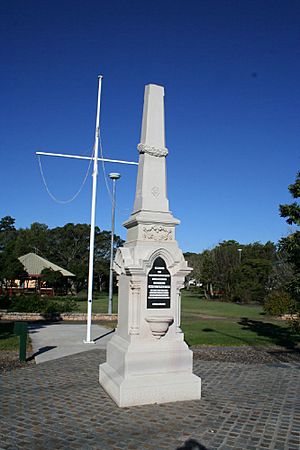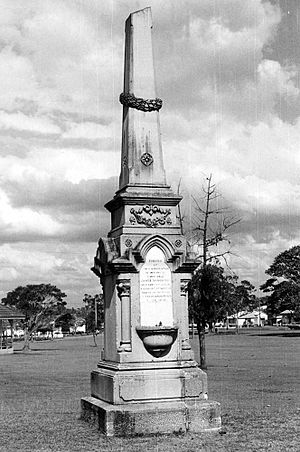James Sangster Memorial facts for kids
Quick facts for kids James Sangster Memorial |
|
|---|---|

James Sangster Memorial, 2008
|
|
| Location | Browns Park, Downs Street, North Ipswich, City of Ipswich, Queensland, Australia |
| Design period | 1870s–1890s (late 19th century) |
| Built | 1898 |
| Architect | C Wilson & Co |
| Architectural style(s) | Gothic |
| Official name: James Sangster Memorial | |
| Type | state heritage (built) |
| Designated | 18 September 2008 |
| Reference no. | 602581 |
| Significant period | 1893 (Floods) |
| Significant components | memorial – column (broken) |
| Builders | C Wilson & Co |
| Lua error in Module:Location_map at line 420: attempt to index field 'wikibase' (a nil value). | |
The James Sangster Memorial is a special monument found in Browns Park, North Ipswich, Queensland, Australia. It was built to remember police constable James Sangster. He was a hero who sadly drowned while trying to save two people during a big flood. The memorial was designed and built in 1898 by a company called C Wilson & Co. It was added to the Queensland Heritage Register on 18 September 2008, which means it's an important historical site.
Contents
A Hero's Story
The James Sangster Memorial was officially opened on Saturday, 7 May 1898. People in Ipswich raised money to build it. It honours police constable James Sangster, who was only 25 years old when he died. This happened in February 1893, when he tried to rescue two people stuck in floodwaters.
The Great Flood of 1893
The 1893 floods were caused by extremely heavy rain. It was called the "Mooloolah rainfall event." Over 1,715 millimetres (about 67 inches) of rain fell in just 72 hours! Three tropical cyclones hit south-east Queensland and northern New South Wales one after another.
The Brisbane River rose very high, causing huge damage. About 52,000 hectares (128,000 acres) of land were flooded. The river rose 3 metres (10 feet) or more above its normal level in some areas. Over two weeks in February 1893, 35 people died, 500 were hurt, and more than 5,000 lost their homes. Over 600 houses were destroyed, and many were washed out to sea. In Ipswich, the Bremer River also flooded. The water was about 2 metres (6.5 feet) deep in Brisbane Street.
A Brave Rescue Attempt
On Saturday, 4 February, the Brisbane River rose near the Jackson family home. This was at Blackwall, close to Kholo, about 10 kilometres (6 miles) from Ipswich. Mr. Jackson was at work. Mary Jackson and a farm worker named John Rowe stayed in the house. Mrs. Jackson and her other children, including 17-year-old Kate, rowed to shore. Kate was a strong rower and swimmer. The plan was for her to go back for Mary and John.
But as their boat neared the riverbank, it flipped over. Mrs. Jackson and one daughter found safety in a tree. Railway workers rescued them. Sadly, Kate, despite being a good swimmer, couldn't hold onto her three younger siblings. All four of them drowned. Their bodies were found a few days later.
Meanwhile, Mary Jackson and John Rowe, still in the house, climbed onto the roof as the water rose. The house then floated downstream and crashed into a large tree. Both managed to hold onto the tree and climb into its branches, above the water.
Constable James Sangster arrived at the riverbank on horseback. He joined a rescue team with a boat. He and another man tried to reach Mary and John. But their boat was swamped by the strong current. Sangster, who couldn't swim, grabbed onto a small tree. The other man swam safely to shore. Rescue attempts continued, but the small tree Sangster was holding onto broke. Constable Sangster disappeared, and onlookers couldn't help him. His body was never found. Mary Jackson and John Rowe stayed in the tree for 22 hours until the water went down. They were then rescued safely.
About Constable Sangster
James Sangster joined the Queensland Police Force on 4 August 1890, when he was 22 years old. He had lived in Queensland for three years, including some time in Charters Towers. He was originally from Aberdeenshire in Scotland and had no family in Queensland. He moved to Ipswich in November 1890 and worked at the North Ipswich Police Station.
Building the Memorial
After the tragedy, the Jackson family decided to raise money to build a memorial for Sangster. A special committee was formed to put a monument in Brown's Park, North Ipswich. The government also gave £20 to the fund.
The memorial was built by Messrs C Wilson & Co. It was placed in a clear spot in Brown's Park. On Saturday, 7 May 1898, it was officially revealed by Alfred John Stephenson. He was a local Member of Parliament for Ipswich. Many people attended the ceremony, and the Brisbane Police Band played music. The memorial originally had a marble lion's head above a fountain bowl.
Unique Memorials
The James Sangster Memorial is special. It's the only known monument in Queensland built by public donations to honour a police officer who died while on duty. Other police officers have had headstones or memorials put up by their police friends or the government. For example, Senior Constable Alfred Wavell had a headstone put up by his friends and the government in 1889. Senior Constable William Conroy had his headstone put up by the government and police officers in 1895.
The Sangster memorial was built when it was popular to create public monuments for important local people. Other public memorial drinking fountains in Queensland include:
- The Eagle Street Fountain in Brisbane, built around 1878-1880. It honours firefighter James Mooney, who died fighting a fire in 1877.
- The Mary Watson's Monument in Cooktown, built in 1886. It honours Mrs. Mary Watson, who died of thirst and exposure with her baby and an employee in 1881.
- The Dr EA Koch Memorial in Cairns, built in 1903. It honours Dr. Koch's work in tropical medicine.
- The FDA Carstens Memorial in Port Douglas, built around 1907-1908. It honours Mr. Carstens' work with the local council.
Looking After the Memorial
In 1989, a stonemason and sculptor named Thomas Andrew Farrell worked on the James Sangster Memorial. Some of the stone and the plaque were replaced. The new stone came from Helidon. The original stone was from Denmark Hill. The first marble plaque, with lead letters, is now kept at the Queensland Police Museum in Brisbane.
Today, the James Sangster Memorial is where the annual Police Remembrance Day service is held in Ipswich. Since 1989, National Police Remembrance Day has been celebrated on 29 September. This date is close to the Feast of the Archangel St Michael, who is said to have fought evil.
The memorial was fixed up again in 2006. The Queensland Government gave $9,600, and the Queensland Police Service gave $1,000. At this time, the monument was moved 15 metres (about 50 feet) further into the park. This was done to make space for widening the road. After this work, the monument was officially re-dedicated on 4 August 2006. This was the same day Constable Sangster joined the police force in 1890.
What the Memorial Looks Like
The James Sangster Memorial is made of sandstone and stands 4.5 metres (about 15 feet) tall. It is located at the edge of Brown's Park, facing Downs Street. Trees are planted on each side, and the rest of the park is behind it.
The top of the memorial has a broken obelisk. This shape symbolises a life that was cut short. The floral wreaths carved on it represent remembering those who have died.
The base of the memorial fountain is simple. Above the base, there is a pedestal with a bowl at the front. There is a column in each corner. Above this, a heavy stone moulding holds the dedication plaque. On the other three sides, there is a laurel wreath carving. Above the plaque, there is another wreath, mostly carved with roses. Below the broken obelisk, there is another wreath and a flower design on each side.
The words on the replacement plaque say:
Erected by public subscription in memory of Constable James Sangster who lost his life in a gallant attempt at rescue in the flood waters of the Brisbane River 5 February 1893
Why It's Important
The James Sangster Memorial was added to the Queensland Heritage Register on 18 September 2008. It is important for several reasons:
- It shows how Queensland's history has changed. The memorial, dedicated in 1898, reminds us of the terrible floods of 1893 in south-east Queensland. Constable Sangster died trying to save people during these floods. The community and government built this memorial to honour his bravery. It is the only known monument in Queensland built by public donations for a police officer who died while serving.
- It's a strong reminder of the past. The memorial fountain clearly shows the impact of the 1893 floods. It also shows how a community dealt with their sadness after one of the biggest floods recorded at that time.



